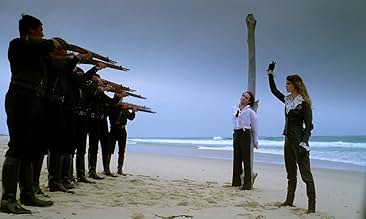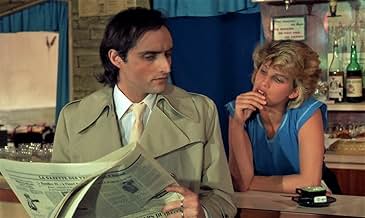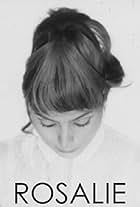Walter is told by his boss, Sara, to deliver an urgent letter to Henri de Corinthe. On the way he finds a beautiful woman he had been eying in a nightclub, lying in the road, bound up. He ta... Read allWalter is told by his boss, Sara, to deliver an urgent letter to Henri de Corinthe. On the way he finds a beautiful woman he had been eying in a nightclub, lying in the road, bound up. He takes her to a villa to get a doctor, and ends up being locked in a bedroom with her. While ... Read allWalter is told by his boss, Sara, to deliver an urgent letter to Henri de Corinthe. On the way he finds a beautiful woman he had been eying in a nightclub, lying in the road, bound up. He takes her to a villa to get a doctor, and ends up being locked in a bedroom with her. While she is making love to him, he has visions of surrealistic images from René Magritte's pain... Read all
- Awards
- 2 nominations
- Le valet
- (as Denis Foucray)
- Director
- Writers
- All cast & crew
- Production, box office & more at IMDbPro
Storyline
Did you know
- GoofsIn the beginning Marie-Ange is found laying hurt in the street near Club Machu, however she can also be seen laying in the road near Walter's apartment in a later scene.
- Quotes
Marie-Ange van de Reeves: I'll find you if I need to. Maybe tonight. Maybe never. Or maybe yesterday. Time doesn't exist for me.
- SoundtracksLe quinzième quatuor (Streichquartett Nr. 15 op. 161. D. 887)
Written by Franz Schubert
Performed by Alban Berg Quartett
EMI CO 6903832
The opening credits are shown in the middle of an open picture frame on a beach, looking to the sea. This is a visual quotation of a habitual motif of René Magritte, and is an immediate flag from Robbe-Grillet that the movie is to deal with Magritte's themes, for example, fetishism, the play of the known and knowable versus the unknown and the unknowable (epistemological concerns), identity, and sensuality.
The level of reference to Magritte tends to become obtrusive: there's a Magritte painting in the libertines' mansion, and an overly expositional shot of the title plate beneath the painting (La Belle Captive - after René Magritte); postcards of La Belle Captive make an appearance, as do objects from the painting; general Magrittean objects such as a dressing gown (cross-reference "Philosophy in the Boudoir", privately owned, Washington DC) and people in bowler hats; finally we're told that slippers are fetish objects (cross-reference "La Modèle rouge", Pompidou Centre) whilst people in general are fetishists. I felt that Robbe-Grillet needed to use his own cinematic language more.
Because the movie is a dream-like there are attempts at the uncanny. Two attempts were slightly elephantine, Sara Zeitgeist keeps her motorcycle in her bedroom, and a man with a bicycle talking to Walter starts wheeling it around in circles and jerking it mid-conversation. Somehow these attempts remain compelling even though the seams are showing.
Just when I thought the movie was breaking records for advertent references, the director introduces a new motif, Edouard Manet's The Execution of Emperor Maximilien. It even transpires at the end of the movie that our hero lives in the Rue Edouard Manet, zut alors!
La Belle Captive is removed from the everyday, just as in Magritte's paintings the quotidian is reduced to the bowler hat. This produces the right hermetic atmosphere for contemplation. Marie-Ange is an enigma, in a way in which every woman must be to some extent to men who view them through the lens of sexual objectification (Marie-Ange literally assumes object status when a group of libertines attempt to buy her from Walter). Characters and objects in Magritte's world are alienated, unknowable, I think this is related to his mother's suicide, and his attempts to understand the event. Robbe-Grillet finds in Magritte ideas about perception and memory that very neatly dovetail with his own.
In the film there is a commentary on how we attempt to know people. When we meet people we attempt to find out their names, their background, and their profession. In my opinion in this process we fundamentally miss the point, and bypass any way of meaningfully understand what is individual about the person we talk to. Marie-Ange is reluctant to tell Walter her name, reluctant that he experience anything about her except what is before his own eyes. She is shown later in the movie bound with a golden chain on which is a plate where we see printed her name, as if she has been bound up by the way in which people seek to identify her.
The ending for me is slightly absurd, in that like many other parts of the movie it is overstated. An attempt to view the dreams of Walter by Professor van de Reeves results from clumsy thinking. Magritte's images (bowler hat, apple, forest, etc) are not Freudian symbols that you might actually expect to see in dreams. Magritte expressly said, "In the images I paint, there is no question of either dream, escape, or symbols".
People who are not interested in perception or Magritte, or even the nature of memory can still find things to like in this movie. Sara Zeitgeist, is beautiful, a modish biker clad all in leather with lace frills bursting out at the bust and the cuffs, her body wed to the gleaming chrome of her motorcycle. (I don't know whether its a deliberate reference, but her name Zeitgeist is perhaps a word that symbolises the opposite of Magritte's and Robbe-Grillet's interests, theirs is a logic out of place and time, concerned with what is essential to being a biological perceiving human. It is therefore not uninteresting that she is presented as the angel of death). There is also the music, which is quite good, especially in the bar scene at the start of the movie (produced feelings of ecstasy in me).
- oOgiandujaOo_and_Eddy_Merckx
- Mar 22, 2007
- Permalink
- How long is The Beautiful Prisoner?Powered by Alexa
Details
- Release date
- Country of origin
- Language
- Also known as
- Die schöne Gefangene
- Production companies
- See more company credits at IMDbPro
- Runtime1 hour 28 minutes
- Sound mix
- Aspect ratio
- 1.66 : 1
Contribute to this page


























